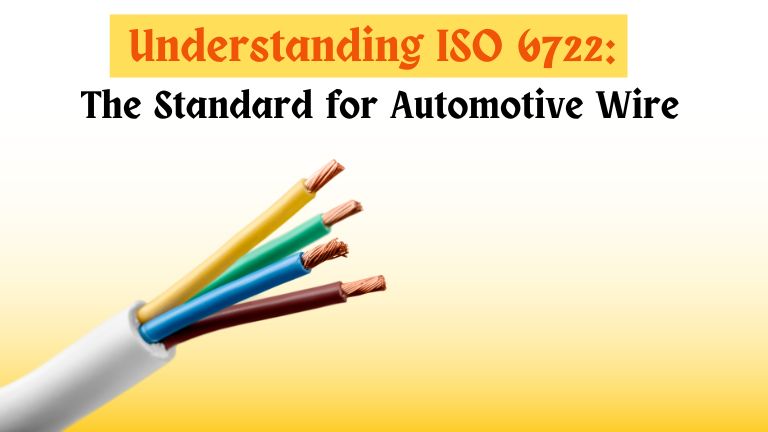ISO 6722 is an internationally recognized standard that sets guidelines for automotive wire. It specifies the requirements for single-core cables used in road vehicles, ensuring reliability, safety, and durability. These cables are critical for electrical systems in automobiles, and adhering to ISO 6722 ensures their performance under various environmental and operational conditions.
This article explores the details of ISO 6722, including its scope, classifications, testing methods, and its importance to the automotive industry.
Scope of ISO 6722
ISO 6722 covers single-core cables designed for the electrical systems of road vehicles. The standard outlines specifications for:
Temperature Resistance: The wires must perform efficiently across a range of temperatures. The standard classifies wires into different temperature classes, such as 85°C, 105°C, 125°C, 150°C, and up to 200°C.
Voltage Ratings: It provides guidance for wires operating in circuits with maximum working voltages of up to 60V DC or 25V AC.
Material Composition: The standard specifies the materials for insulation and conductors, ensuring optimal performance and longevity.
Environmental Durability: The cables must withstand exposure to oil, fuel, and other automotive fluids, as well as physical stresses like vibration and abrasion.
Classification of Wires Under ISO 6722
ISO 6722 divides wires into two main categories:
- Type A Cables: These cables are designed for general-purpose use and must pass stringent mechanical and electrical tests.
- Type B Cables: These are lightweight wires optimized for specific applications where reduced weight is critical, such as in modern electric vehicles (EVs).
Further classifications are based on:
- Conductor Material: Copper (bare or tinned), aluminum, or alloys.
- Insulation Material: PVC, XLPE, silicone rubber, or other polymeric materials.
- Temperature Class: Determined by the highest temperature the cable can endure without degrading.
Key Requirements of ISO 6722
The standard ensures that wires meet specific performance criteria through rigorous testing procedures, which include:
Electrical Testing
- Voltage Test: Verifies that the insulation can withstand specified voltage levels.
- Conductor Resistance Test: Checks the resistance of the conductor to ensure efficient electricity flow.
Thermal Testing
- Heat Aging Test: Evaluates the insulation's durability at high temperatures over extended periods.
- Low-Temperature Bend Test: Confirms the cable’s flexibility and integrity at low temperatures.
Mechanical Testing
- Abrasion Resistance Test: Measures the wire's ability to withstand wear and tear.
- Tensile Strength Test: Ensures the conductor and insulation materials can withstand stretching forces.
Chemical Testing
- Fluid Compatibility Test: Ensures the wire can resist degradation when exposed to automotive fluids like fuel and oil.
- Corrosion Resistance Test: Assesses the conductor’s ability to resist oxidation and corrosion.
Importance of ISO 6722 in the Automotive Industry
Safety Assurance: Electrical systems are vital in modern vehicles, powering everything from lights to complex control systems. ISO 6722-compliant wires minimize the risk of failures like short circuits or overheating, enhancing overall vehicle safety.
Performance Consistency: By adhering to this standard, manufacturers ensure that automotive wires perform reliably under diverse conditions, including extreme heat, cold, and mechanical stress.
Environmental Compliance: The standard emphasizes the use of eco-friendly materials and manufacturing processes, aligning with global sustainability goals.
Compatibility with Advanced Technologies: Modern vehicles, especially electric and hybrid models, demand high-performance wiring systems. ISO 6722-compliant cables are tailored for these advanced technologies, ensuring seamless integration.
Global Recognition: ISO 6722 is widely accepted by automotive manufacturers and suppliers worldwide. Compliance with this standard enhances a product’s credibility and marketability in the global automotive sector.
ISO 6722 and Emerging Trends in Automotive Wiring
The automotive industry is undergoing rapid transformation with trends like electrification, automation, and connectivity. These developments pose new challenges and opportunities for automotive wiring systems:
Electric Vehicles (EVs): EVs demand wires that can handle higher voltages and currents. ISO 6722 is being adapted to accommodate these requirements, ensuring wires are safe and efficient.
Lightweight Materials: To improve fuel efficiency and range, manufacturers are increasingly using lightweight materials. ISO 6722 supports this trend by specifying wires that maintain performance while reducing weight.
Advanced Insulation Materials: Innovations in polymer technology are leading to more durable and heat-resistant insulation materials, which comply with ISO 6722’s evolving specifications.
Environmental Sustainability: With a growing focus on reducing the environmental impact, ISO 6722 encourages the use of recyclable materials and processes in cable manufacturing.
Challenges in Implementing ISO 6722
Despite its benefits, implementing ISO 6722 comes with challenges:
- Cost Implications: Compliance with ISO 6722 involves advanced materials and rigorous testing, which can increase production costs.
- Technological Adaptation: Manufacturers must continually update their processes and technologies to meet the latest revisions of the standard.
- Global Variations: While ISO 6722 is a global standard, some regions may have additional requirements, necessitating customization.
Conclusion
ISO 6722 plays a pivotal role in defining the quality and performance of automotive wires. By establishing stringent standards for durability, safety, and reliability, it ensures that these essential components meet the demands of modern vehicles. As the automotive industry continues to evolve, ISO 6722 remains a cornerstone of innovation and excellence, guiding manufacturers in creating wiring systems that power the future of mobility.

